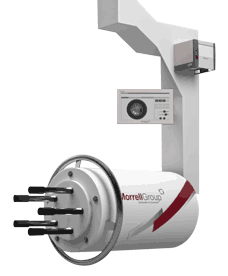How difficult is it to tighten a fastener? A simple question at first glance, but more challenging to answer when you break down what needs to be addressed to answer the question. Consider safety issues, quality control requirements, data capture, time, and the type of process being performed. With so much to think about, it suddenly seems more difficult to tighten a fastener than the initial question suggested. In this episode of Evolution in Controls, special guest tightening product manager Jim Ross joins host Tim Wilson to talk through what tightening tools look like in today's world of intelligent, complex, and ever-growing technology.
Jim explains the concepts involved in tightening: the joint being assembled, the torque needed to fasten the component, and the required revolutions to secure the fastener. These three items are essential when tightening a fastener because they determine the quality of the assembly, which can have safety implications. Understanding the joint being assembled means knowing the amount of clamping pressure. Years ago, with entirely manual tightening processes, bolts and nuts were oversized because it wasn't possible to know the exact amount of clamping pressure needed to ensure safety and quality. With today's technology, tightening tools can provide instant feedback on torque, angle, and rotation to know the precise amount through feedback from the tools.
Torque, or how much a fastener is turned, is the next essential concept of tightening. Jim notes that when tightening, there is a pre-torque, a final torque, and, on some occasions, a condition - a process in which a fastener is tightened, loosened, and then retightened to ensure everything is aligned correctly. Applications of every kind require specifications for how much a fastener should be torqued. Under- or over-tightening can have safety and quality consequences for manufacturers and end users.
Like torque, applications have revolution specifications, or a certain number of times a fastener must turn. In those revolutions, there should be no binding of the threads. By monitoring revolutions and torque simultaneously, you can see if there is any thread interference before the fastener gets to the final torque. After discussing these three tightening concepts, it seems like tightening a fastener is, in fact, a difficult task. But it doesn't have to be with how far today's technology has come.
This is where Bosch Rexroth tightening tools come in. The OPEX Wrench is a digital manual torque wrench with a transducer that provides feedback on angle, rotation, and torque as it operates. With a built-in control system, the OPEX collects all tightening data that can be sent out via WiFi to an FTP server. The NEXO 2 tool is a manual tool with a servo drive that continuously rotates and stops when the correct torque has been reached. It's programmable through an onboard software program and a smartphone, making the NEXO a user-friendly and easy-to-use tightening tool.
While tightening technology has reached a great spot and may mostly stay the same in the coming years, Jim predicts automated and intelligent tightening tools will only become more prevalent thanks to their data recording capabilities. By keeping accurate and secure track of all tightening data, safety and quality can be monitored and ensured.
To learn more about Morrell Group and Rexroth tightening tools, please visit https://morrell-group.com/bosch-rexroth-tightening/. To stay up-to-date on our latest systems and solutions, follow our LinkedIn pages: Morrell Group and Womack Machine Supply.
Watch another episode
Introducing the Industrial Hydraulics Sales Division
Kevin Kampe and Ben Page discuss the new industrial hydraulics sales division and what it means for the company and customers.
Listen to the latest episodes
Resources
Automated Tightening System
The Automated Tightening System is a semi-trailer manufacturing solution that accurately and precisely tightens wheel lug nuts to the correct specs while recording and storing all tightening data.
Bosch Rexroth Tightening
Morrell Group and Bosch Rexroth have partnered to offer a premier line of tightening products for every application. With Bosch Rexroth patented digital transducer technology, we can provide one of the most accurate, reliable, and robust systems in the industry. Bosch Rexroth's commitment to manufacturing standards allows us to offer the best warranty, even at the full load capability of the tool. We offer a complete line of custom tightening solutions, which include torque reaction, gantries, worker guidance, data collection software, an extensive line of accessories, and more.
Bosch Rexroth Tightening Controls
The standard products from Bosch Rexroth Tightening offer single tool controllers and multi-tool controllers. Single tool controllers are provided in both graphic and standard display. Multi-tool controllers provide the ability to operate up to 6 tools per controller, and can synchronize up to 40 tools with 7 multi-tool controllers. The single tool controllers and the multi-tool controllers are designed to operate both the DC electric ErgoSpin hand tools and the DC electric fixtured spindle tools.









